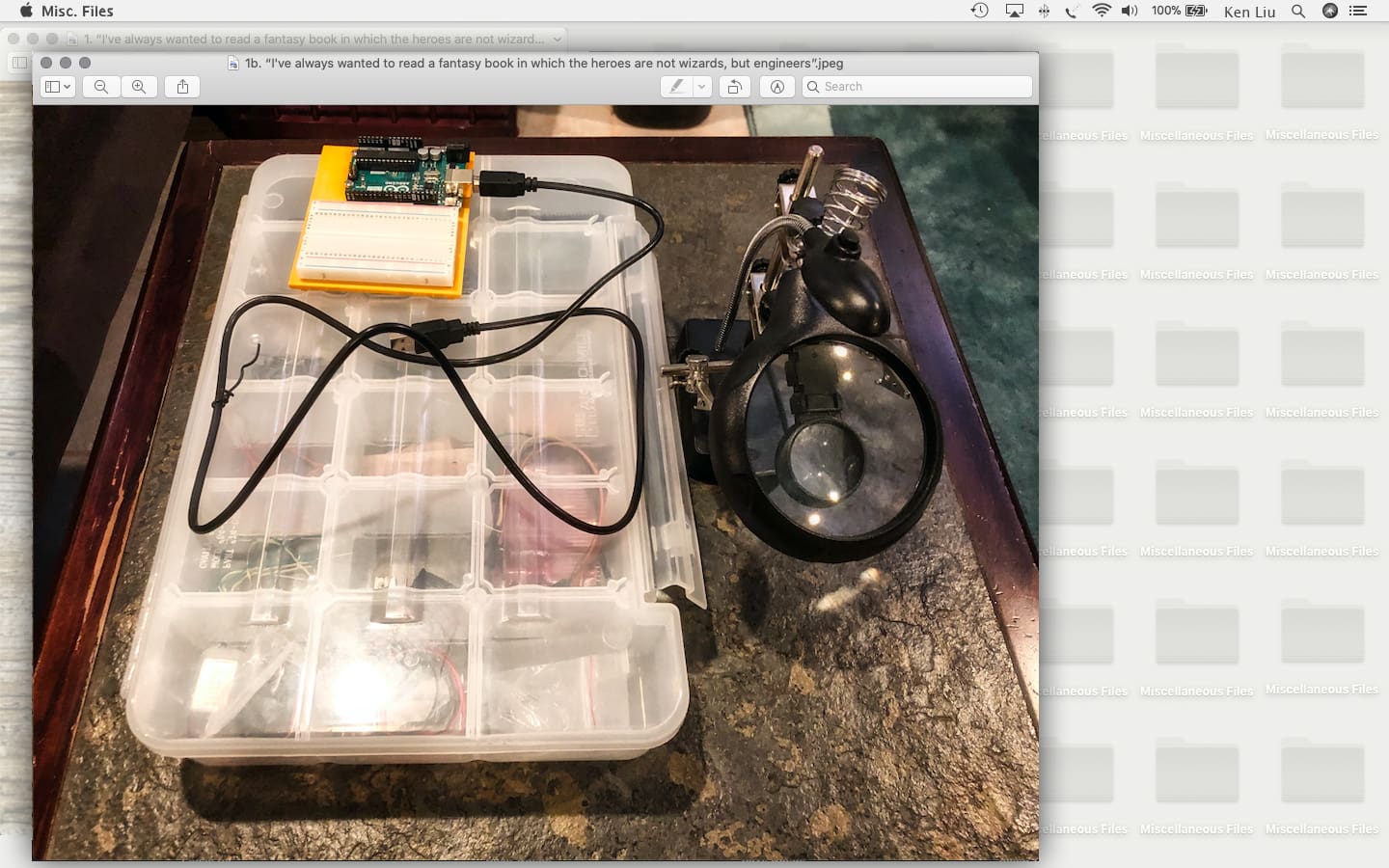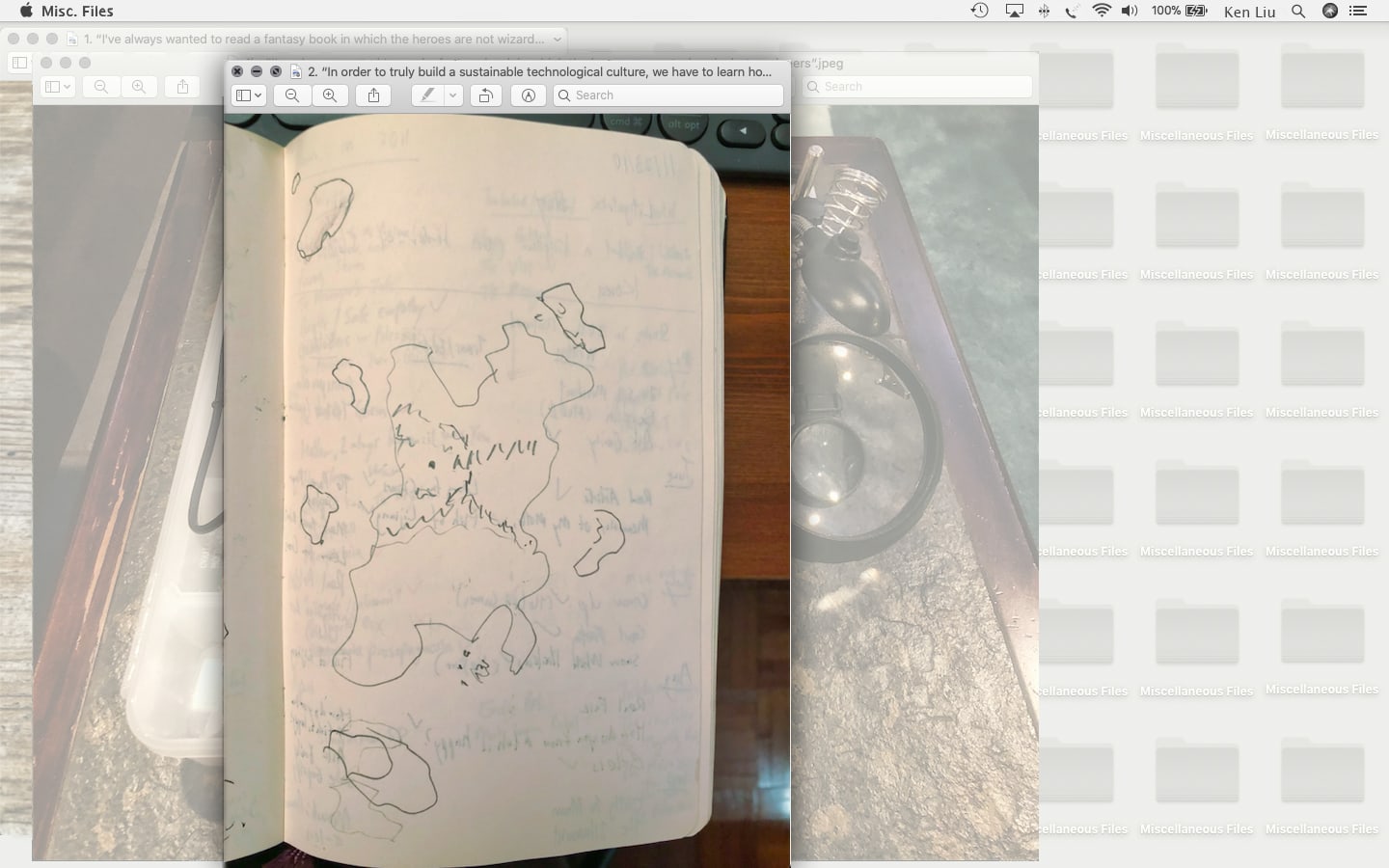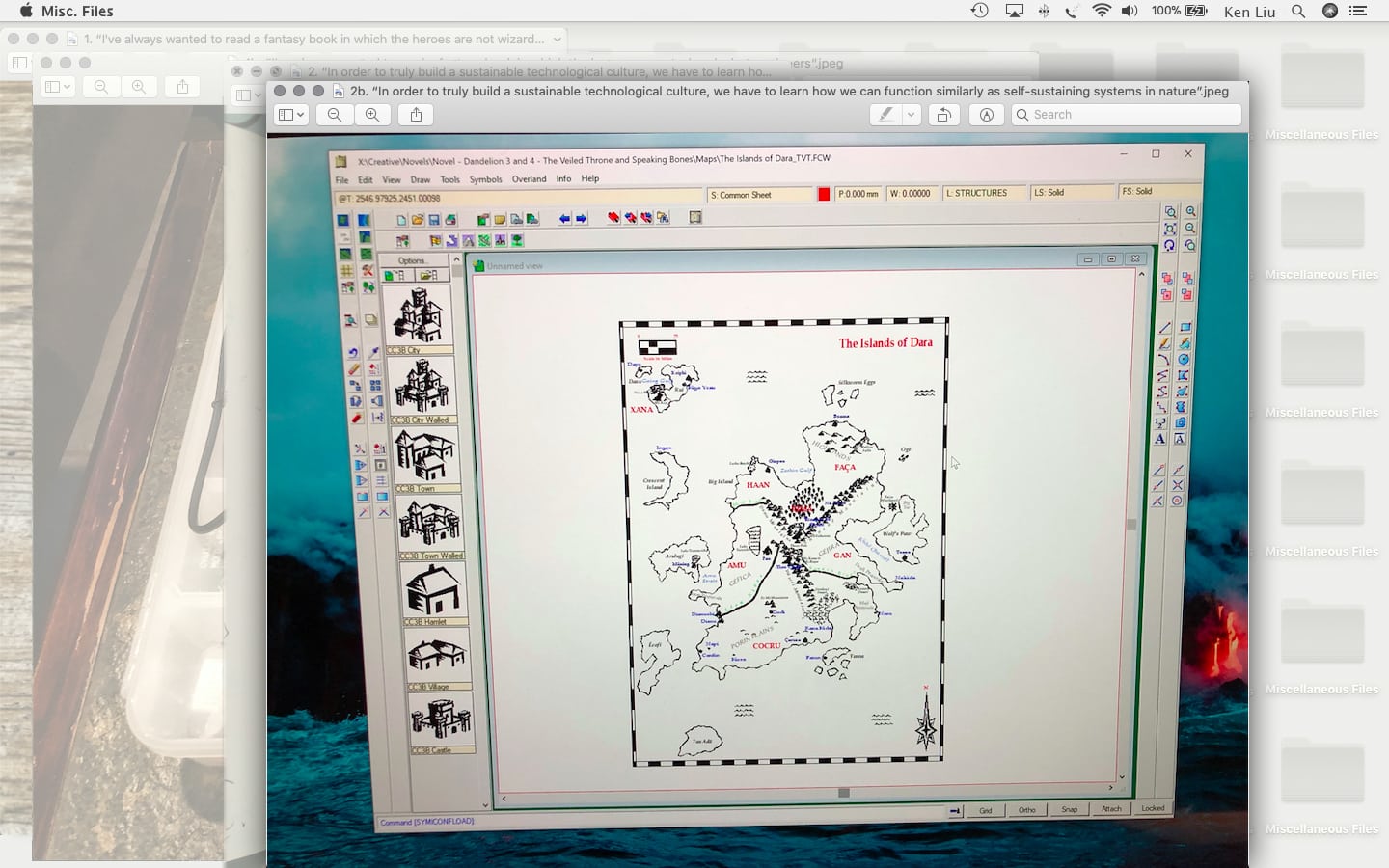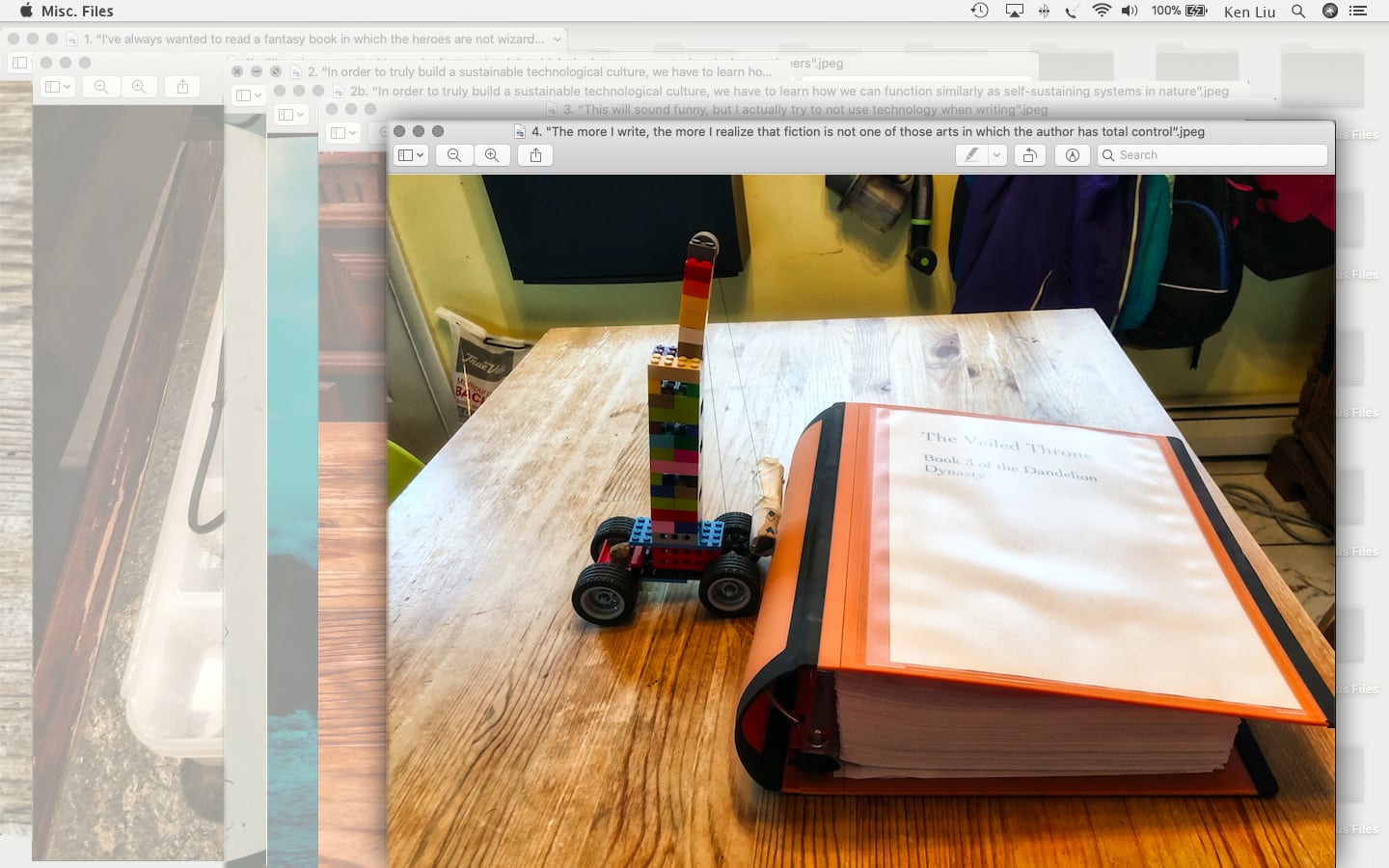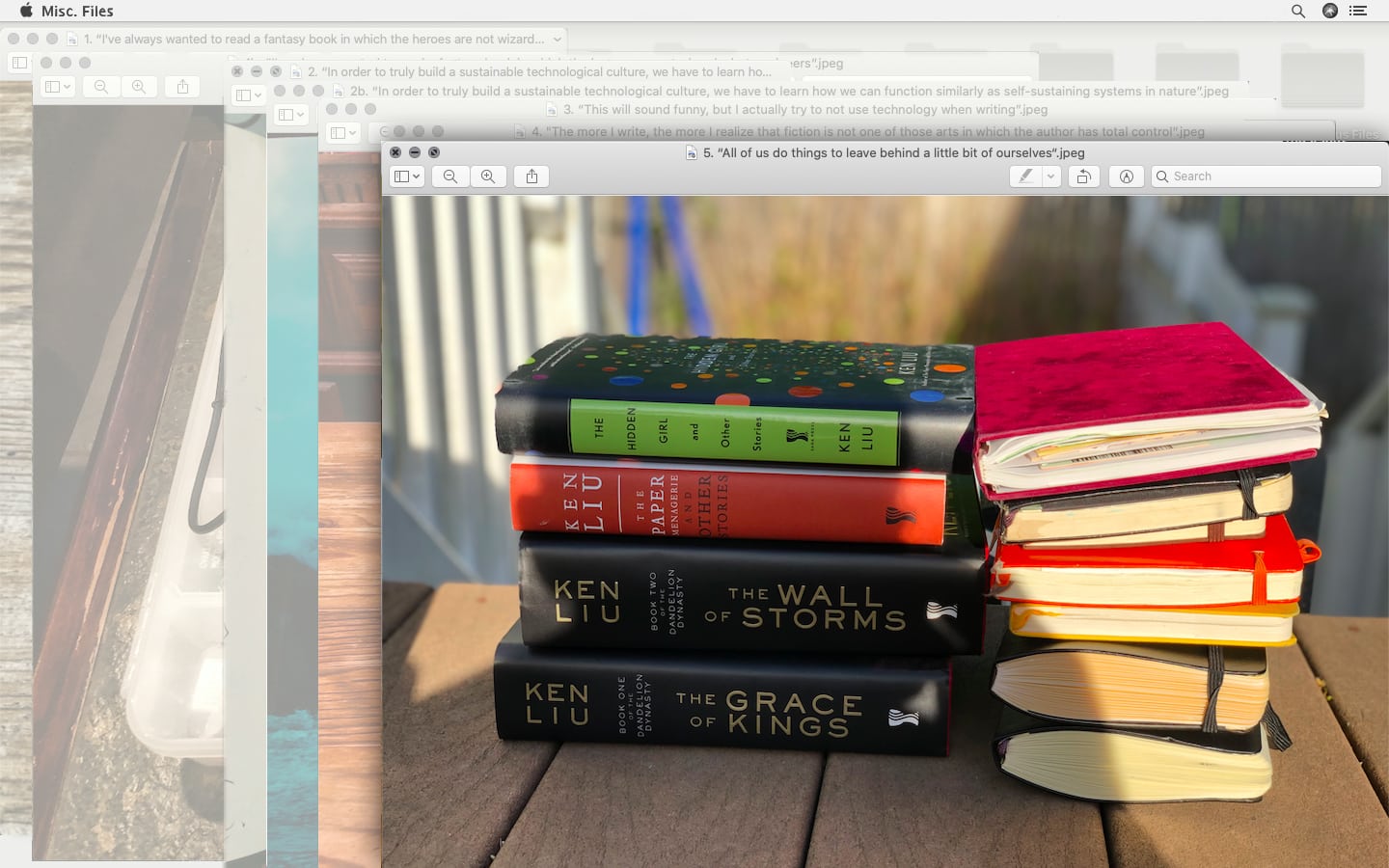Miscellaneous Files is a series of virtual studio visits that uses writers’ digital artifacts to understand their practice. Conceived by Mary Wang, each interview provides an intimate look into the artistic process.
In Ken Liu’s short story “An Advanced Readers’ Picture Book of Comparative Cognition,” a child grows up between parents pulled in opposite directions. The child’s mother, hardened from a young age by a sailing accident, decides to travel toward the sun as an attempt to communicate with alien worlds. Her father, more interested in life on earth, questions the mathematics and logic involved in that attempt. “I’ve always found it funny,” he muses, “that we think the best way to communicate with extraterrestrials is to speak in a way we never do in life.” Such opposing forces are embedded in many of Liu’s speculative stories, where alien worlds are explored through distinctly human ideas: his characters, human or not, are driven by history and memory, racing forward amidst hope and regret. Set in lands real and imaginary, each story is both a family portrait and a thought experiment, a character study of often epic, planetary scales.
“Each star is a living text,” Liu writes in his story “The Bookmaking Habits of Select Species,” “where the massive convection currents of superheated gas tell an epic drama, with the star spots serving as punctuation, the coronal loops extended figures of speech, and the flares emphatic passages that ring true in the deep silence of cold space.” In Liu’s world, everything—whether it’s an heirloom, a pictogram, or a planet—contains its own poetics. Perhaps it’s his ability to discover stories in every form of being that allows him to be so prolific. Liu is the author of the collections The Paper Menagerie and Other Stories (its title story was the first to win all three major sci-fi honors: the Nebula, the Hugo, and the World Fantasy awards) and more recently, The Hidden Girl and Other Stories. He also wrote The Dandelion Dynasty epic fantasy series, three novels about rebellion and resistance told through a technological language based on East-Asian materials and philosophies. On top of that, Liu is a translator credited with popularizing Chinese writers of science-fiction with English readers, including Liu Cixin’s acclaimed The Three-Body Problem.
Ken Liu’s own narratives spiral and meander. His characters move from the inside outwards, only to find themselves circling back, changed. His language draws on the hallmarks of sci-fi, romance, and epic sagas, among other genres, only to defy them. His narrators are often children, posing questions adults are unwilling to answer. It’s through such eyes that a reader might enter Liu’s work: We return to a tender age, at which we experience unfamiliarity as a thrill, and embrace all that’s novel and odd with curiosity and love.
Perhaps that’s why the timing of my conversation with Liu felt prescient, taking place during a pandemic that is exploding so much of what we thought we knew. As all conversations go these days, we spoke over Skype and started by negotiating the set-up of our cameras and microphones and screens. We spoke about the stories he grew up with, technological lineages as languages, and the different heroes’ journeys he’s incorporated into his work. In times like these, Liu’s conception of heroism is worth keeping close to our hearts: It’s through our everyday acts of compassion, and the love stories we tell ourselves and each other, that we gradually become the myths of future generations.
1. “I’ve always wanted to read a fantasy book in which the heroes are not wizards, but engineers.”
Mary Wang: I’m really excited about the materials you sent through. Those 3D-printed prototypes look so cool! Maybe we can start with them?
Ken Liu: Thank you! The Dandelion Dynasty series is really a love letter to the practice of engineering. My first profession was as an engineer, and I like building things, so I’ve always wanted to read a fantasy book in which the heroes are not wizards, but engineers. Engineering is a much older art than science. Every society has practiced it since the Stone Age, and it’s about learning a standard set of techniques passed down from your predecessors, and then to use and combine them in new ways to solve new problems. In that sense, engineers are a lot like poets: You acquire the tropes and techniques of your literary or engineering tradition, and then you innovate and combine them into new poems or machines. This is the view of engineering I wanted to get across.
I also wanted to celebrate underappreciated traditions of engineering, especially those from East Asia. So I invented this alternative technological vocabulary I call “silk-punk,” which is an engineering language and style based on traditional materials available in East Asia such as silk, bamboo, animal sinew, paper, and feathers. The grammar of these technologies is based on traditional East Asian philosophies of harmonious existence between the artificial and the natural. As part of this, I invented these new machines, which I then had to prototype to make sure they actually work. I needed to at least convince myself that in the fantasy world, assuming the laws of physics were not drastically different from ours, they would function. So I used Legos to build self-propelling machines, and I 3D-printed little airships so that I could figure out how they’d relate to each other and choreograph the battle scenes.
In the later books of the series, once the engineering tradition in this fantasy world discovered electromagnetism—which they call the silkmotic force because they discovered it by rubbing a piece of silk against a glass rod—I had to prototype some circuits to make sure these engines actually worked. A lot of these were based on the very earliest experiments in electrostatic machines in the 17th and 18th centuries. Since many of the silk-punk machines use simple electronics, it was also helpful for me to model their circuits. Turns out, it was also helpful to have these for household repairs and to help my daughters with wiring in their miniature furniture and houses.
Wang: If you were a different type of writer, I might ask you how you conceive of characters and build plot. But since you talk about engineering as a language, it would make more sense for me to ask how you conceive of technologies. How do they come about, how do you then refine them, and finally, how do you incorporate them into the story?
Liu: I love talking about this stuff. My other former careers consisted of being a litigation consultant and a corporate lawyer, so I did a lot of research into the history of patents and the history of technology. That turns out to be a great way to find inspiration for fictional machines. If you go into patent databases, you’ll see tons and tons of interesting inventions that never went anywhere. But that doesn’t mean that, in an alternate universe, they couldn’t have become successful and become the progenitor of new lineages of machines.
I also get a lot of inspiration from reading about archaeological discoveries of ancient machinery. The Chinese had invented these amazing compound looms that could be programmed to create complex textile patterns, and we didn’t know how they worked because they didn’t survive. But the latest archaeological discoveries actually found some of these looms, or models of them made out of ceramic as grave goods, so archaeologists have been able to recreate them and figure them out. They were amazing, like mechanical computers that could be programmed to weave specific patterns. Similarly, archaeologists realized that Heron of Alexandria, a great Greek inventor of antiquity, had devised all sorts of machines for temple magic as part of religious rituals. That turned out to anticipate many of our modern ideas about cybernetics and autonomous control.
These lines of technology didn’t go very far, but in the fictional world I was creating, I could take it as far as I wanted to. So I built these “instructable machines,” meaning that you could teach them what to do, taking the principles of mechanical looms and these inventions by ancient Greek engineers. It was fascinating to invent this alternative technological universe, and then figure out what sort of stories can be told in them. I liked to imagine these ideas, build little models to see how they could function better, and then write pseudo-scientific papers about them for myself, like little Wikipedia entries. That’s how I did the world-building. Only once the world was fully realized did I start to imagine what the characters would do in that world.
I think it’s actually relatively rare to have an epic fantasy series focused on the dynamic evolution of a particular vision of technology, like The Dandelion Dynasty books. Rather than a portrait of a society yearning to return to stasis, everything in Dara is always changing, including its technology. Electromagnetism is discovered somewhere in book two, so starting from there to the conclusion of the series, you’ll see how the people of Dara learn to use this force, how they invented new prototypes and evolved more elaborate machines on top of those, until you get a whole ecology of silkmotic technologies.
Wang: You tasked yourself with the invention of a new technological ecology, but by doing that, you also established very specific narrative constraints, albeit through engineering principles. It’s like you also invented a system for determining plot.
Liu: That’s right. In many ways, the military tactics in the books were determined by the evolution of technology. And I end up talking about how military tactics and social organizations are also types of technology. People had to invent new ways of organizing the fighting forces as well as mobilizing the civilian population in order to support new ways of fighting wars.
2. “In order to truly build a sustainable technological culture, we have to learn how we can function similarly as self-sustaining systems in nature.”
Wang: You sent me the maps you drew of Dara, the fictional world in which The Dandelion Dynasty books are set. There’s a sketch and something you plotted using software.
Liu: The whole series actually started with that hand-drawn map. I had to draw it for myself first to be able to envision what the nations and the overall setting would be like. Later on, as I wrote the novels, I needed better maps to help guide the thinking, so I had to learn how to use these mapmaking tools. Ultimately, we had to commission Robert Lazzaretti, an artist, to draw the map for the official publication. The geography mattered a lot. In the novels, the world of Dara is just as important as any of the other characters. The entire setting itself is a character that had to be described and evolved, so I had to get to know it the same way I would have gotten to know any character.
Wang: You often equate geographical constraints with technological ones, which reminds me of your story “An Advanced Readers’ Picture Book of Comparative Cognition.” In the story, a character describes the earth as “just a big raft in the sea of stars.” Your stories often describe the natural world in technological terms, and the other way around.
Liu: Technologies are no different from any other kind of self-sustaining, self-contained ecosystem. There is a way in which we can see technology and nature not in opposition, but rather as the same thing manifested at different scales. In order to truly build a sustainable technological culture, we have to learn how we can function similarly as self-sustaining systems in nature.
3. “This will sound funny, but I actually try to not use technology when writing.”
Wang: Let’s talk about the relationship between technology and your writing practice. Many of the photos you sent me feature some type of writing technology, including the software you used to create the map of Dara.
Liu: That software is called Campaign Cartographer. It’s often used in role-playing games, and by dungeon masters to create fantasy maps. A lot of authors enjoy using the software to create maps for their own worlds. It’s not limited, of course, to fantasy. I believe that people have used it to create space stations and modern cities, too.
This will sound funny, but I actually try to not use technology when writing. There are a lot of complicated features in software marketed toward writers, but I find that they just get in the way. For my short stories, I prefer to draft in a plain text editor using Markdown, which is a markup language similar to HTML, but much simpler. This way I don’t have to deal with formatting, fonts, and all the rest of it. It’s just plain text. Only when I’m done drafting do I compile it into a Microsoft Word document so I can send it off to the publisher. For the novels, I use Scrivener. It’s very helpful for handling a very large, structured document composed of smaller units, but I don’t use any of the fancy features and try to keep it as simple as possible.
Honestly, if my handwriting wasn’t so bad, I would write longhand. Unfortunately, I never learned to write properly, and I always got terrible marks for penmanship. As a lawyer, my administrative assistants could never do my timesheets because my hand-scribbled notes were utterly illegible. In college, I had to type up my notes soon after I took them, because if I waited too long, I would not be able to decipher my own handwriting.
Wang: You’ve said before that your previous professions in law and engineering helped you understand the structure and importance of storytelling. But I wonder whether there were certain conventions or habits you had to unlearn, too.
Liu: The transition from software engineering to law was very interesting to me: When you’re a software engineer, you learn that it’s really terrible to copy and paste, because that increases the chances of error. In law, however, you take the same thing and put it in multiple places verbatim, because there’s an inherent culture of conservatism. As a fiction writer, I ended up having to unlearn both habits, because efficiency is not necessarily ideal. It’s not the case that, because you said something once, you should never say it again. Often, to achieve emotional resonance in fiction, you do want to repeat the thing that you care about in the right places. At the same time, just because something was done in the time of Charles Dickens doesn’t mean it has to be done that way now. I’ve had to learn over time that you can’t always follow an idealized model, but at the same time, it’s not true that what’s latest is always greatest. You have to find the right set of techniques for each story..
For example, in my novel series, I do something that’s not often seen anymore, which is using an omniscient point of view. Modern novels are very rarely told that way. But I realized that I didn’t want my epic fantasy to be like a modern epic fantasy. The whole series was, in some ways, a deep exploration of the idea of foundational narratives. Nations are founded on mythologies, so especially The Grace of Kings, the first book, needed to be told from an omniscient point of view, so it could acquire that kind of mythological stature, and support the series that is built on top of it. Adopting this point of view does read old-fashioned and strange and distant, but that was deliberate. It had to give readers that estrangement so they can get it into their heads as a foundational mythology. That way it would be so much more satisfying artistically when new characters came in later and reinterpreted these stories. The very literary style in the later books in the series changed to reflect the shifting nature of narrative from the mythic to the personal.
4.“The more I write, the more I realize that fiction is not one of those arts in which the author has total control.”
Wang: Many different types of heroes and heroes’ journeys appear in your novels. Tax collectors, scholars, and thieves all emerge as kings, though in different ways. You’ve said that, for The Dandelion Dynasty, you took inspiration from different types of sagas including The Iliad and The Odyssey and The Romance of the Three Kingdoms. How have these traditions informed your understanding of what a hero is?
Liu: I worked on the series over a full decade, so my thinking on this has evolved over time. At this point, I would say that the best way to think about the series is as a meditation on the way each of us crafts our own narratives and gives meaning to our lives by making ourselves into the heroes of our own stories. Life and the universe are fundamentally random. There’s no plot, no higher design, no character arc to our lives. A lot of the most important things we live through are determined by random chance and happenstance, but we as human beings don’t understand the universe that way. That understanding doesn’t help us or give us hope; it doesn’t give our lives meaning. So we end up having to craft a narrative for ourselves. To make sense of it all, we have to create a character arc, a plot, causes leading to effects, a set of values worth living and dying for.
The most important part is the set of values, right? We all have a prototype story in our heads that defines what particular values mean. For me, if we’re talking about love, the story that always comes to mind is of my grandmother when I was a very small child. In the winters, she would try to knit sweaters for me, even though she had arthritis. Her fingers were not as nimble as they used to be, and she had rough, cracked skin. It was clear that it was very painful for her to be doing this kind of work, so I asked why she did it. She said she did it to make sure I wasn’t cold. That, to me, is the core defining story of what love means.
All of us have stories like these that define our values and who we are. The protagonists in these stories—teachers, parents, friends, lovers—are our guides in our life’s journey. They are the gods and heroes of our own epic fantasy. As we craft our own life forward, we learn to emulate these stories in our own lives, and as we grow older and embody these virtues and live them out, we in turn become the protagonists of myths and stories that inspire others who come after us. This is how culture is passed on, how each generation renews the hope of those who come before it.
In my epic fantasy, this is a core organizing principle at all levels. Important figures from the first book pass into myth and legend to inspire those in later books, and they, in turn, reify ideals and embody virtues that must then guide the generations after them.
Wang: The way you talk about this reminds me of one of the earliest stories you published, “State Change.” A lot of what you’re describing for your novels was already embodied in that story, but on a much more intimate scale. In fact, it’s probably one of your most intimate stories, which might be why I like it so much. I find it profoundly moving how the main character lives her life according to a story she’s been told since she was born. But then, through engaging with the other stories around her, she realizes she can change.
Liu: Maybe I was thinking about this back then without necessarily being able to articulate it. But yes, “Stage Change” is really about the main character trying to figure out what her story is. Our own stories are not printed in a book. They’re not fixed; they’re not finished. We are in control of where to go next. Once we understand that, we can seize the initiative and define our own epic journey. We get to define the stories we want to be told about us.
Wang: Many of your stories have other stories nested in them. In “State Change,” the main character lives amidst the biographies of historic figures ranging from Edna St. Vincent Millay to Joan of Arc. You’re clearly a very wide reader yourself, and it makes me wonder how you live amidst other stories while you’re writing.
Liu: It’s actually a big challenge for me. I’ve always found that it’s best, when I’m writing a story, to avoid reading stories that are too close to it, because you don’t want to be too influenced by a narrative that’s very close to your own. For example, when I was working on the epic fantasy, I avoided reading all other epic fantasies. But I ended up reading very widely in other areas, because sometimes that will give you more inspiration. The human mind is really good at making associations between things that are otherwise unrelated. The more you can do that, the more original your ideas will be. So I ended up reading a lot of nonfiction about technology, ecology, and the history of cryptography, and other very technical subjects. The stories of how people came to discover various technologies are fascinating: there are wonderful stories behind how sneakers came to be, how typewriters evolved, or even how the thermos was invented and refined over time. I used to be a tax lawyer, and people always said it must be so boring. But if you delve deeply into any subject, you’ll discover all kinds of fascinating stories. Ultimately, they’re all human practices, and humans are endlessly fascinating.
I also read a lot of romances, which are fundamentally about social engineering—about hacking the social system to achieve what characters want to achieve. I find that to be just another way of thinking about hacking and playing with technology, except that you’re dealing with rule systems of a different sort. I also read a lot of poetry. Poetry is not usually a narrative form, but it’s more about evoking stories, feelings, and negative spaces, that the reader can then fill in. That actually ended up having a huge effect on me. I’ve explained it through this metaphor in the introduction to The Hidden Girl: A fictional text is really a space created by the writer into which the reader is invited to play and create the reader’s own meaning. The more I write, the more I realize that fiction is not one of those arts in which the author has total control. It’s actually one of the most collaborative arts, because the role of the reader is so much more powerful in the interpretation of fiction than it is for music or painting.
As the author, you cannot literally control what the reader sees. When I talk about love, I think about that story involving my grandmother. But no other reader is going to have that story in their heads when they read the word love. So by necessity, every single word I put down on the page will be interpreted by every reader in their own way, because every reader comes to the text with their own set of stories, their own set of interpretive frameworks, their own baggage, their own emotional resonances, and then they read your words and construct a whole new world. So the final creation is really half mine, half the reader’s. And because of that, as an author, I’ve learned over time to let go more. I think authors early on often feel that if readers are not understanding their story the exact way they want them to, they must’ve failed. But it often just means that they don’t share the same interpretive framework. It’s actually a very beautiful collaboration between the reader and the writer. So I may publish just one story, but there will end up being thousands, if not tens and hundreds of thousands of different stories, as every reader interprets it their own way.
5. “All of us do things to leave behind a little bit of ourselves.“
Wang: Chinese language plays a big part in many of your stories. Often you include pictograms that are somehow integral to the narrative, building on the way Chinese pictograms already contain many narratives and histories in each character. You’re bilingual, and also a translator of Chinese science fiction. How does living so closely with the Chinese language affect your reading and writing?
Liu: It’s hard to say, because it’s like saying, “How does living in the world affect the stories you tell?” The answer will always be, of course, a lot, but it’s hard to articulate it in a precise way. I would say that being bilingual and working with two languages makes me more skeptical of claims about universalism. Oftentimes, when you attend workshops or talk about craft as a writer, you hear people making universalist claims, like how first person narratives are always better because they make you more empathetic to the character, or how adverbs are terrible, that you should show not tell. But anybody who reads widely and tries to keep an open mind about art will realize that these claims are foolish. When you’re bilingual, you get exposure to an even greater variety of writing styles and linguistic features, so it’s even more obvious to you that many of the things we accept as universal are mere conventions uniquely suited to one time, one place, one culture, one group of readers. Accepting the full diversity of human nature and the way humans tell stories inspires all of us to tell more interesting stories.
For example, in Dara, the language is not really like Chinese at all, because Chinese is fundamentally a phonetic script that happens to be less transparent than an alphabet is. The language and the script I invented for Dara, Classical Ano, however, is much more distant from a purely phonetic script even than Chinese. So, in some sense, I decided to take a few peripheral features in a script like Chinese and centered them and pushed them much further until I created a new script that is not found in human scripts at all, at least among the ones we know. And then I dug deeply into this invented script—it’s three-dimensional; it’s malleable to the representation of different languages; it’s simultaneously conservative and friendly to innovation; it’s ideographical (in a true sense, not in the misunderstood sense when applied to Chinese hanzi)— and explored how that interacts with the way we think about writing.
As you mentioned earlier, I’m endlessly fascinated by writing scripts, and by techniques for conveying information. I often joke about how “The Bookmaking Habits Of Select Species,” another story I wrote, is the micro version of The Dandelion Dynasty, because ultimately, the fantasy series is about different ways of recording information; different ways of creating scripts to represent cultures, ideas, thoughts, and feelings; and about how we human beings are obsessed with passing on something of ourselves. Some of us try to pray, some of us try to inspire others. Some of us try to be great parents. But all of us do things to leave behind a little bit of ourselves.
Wang: This reminds me of the connection you make in your short story “Ghost Days” between aliens, as in extraterrestrials, and aliens, as in non-citizens. You then link the notion of foreigners to the Cantonese word laoguai, which means old ghost as well as foreigner. From there, ghosts are only a few steps away from gods. I find that very moving, to use space travel as a metaphor for migration. Your stories make the point that, as long as you change and enlarge contexts enough, all outsiders will become insiders again, and the other way around.
Liu: That’s a really beautiful way of putting it. I’m often trying to play with the idea of who’s an insider and who’s an outsider. A lot of my characters are the ultimate insiders who end up as outsiders. Then they end up on the inside again, but in a transformed way. I think that’s actually a more universal experience than we’re willing to acknowledge. In modernity, with increased social and geographic mobility, we all experience growing up in one place and then going off somewhere else, for example to college, and having to learn to code switch and reinvent ourselves. We might then end up settling in a city that’s not the place of our birth, and have to go through this process of reinventing ourselves yet again. And then when we go home to visit our parents for the holidays, we realize how different we’ve become. Immigration and migration are just very extreme manifestations of it.
Wang: It would be a missed opportunity if I didn’t ask you about the pandemic we’re living through. No question is big enough to capture these conditions, so I’d just like to ask: How are you responding to this as a writer?
Liu: This is an extraordinary moment, and I have found myself unable to write about the near future, at least for the moment. It’s a little bit like going through 9/11. Other writers have said how, when 9/11 happened, they had to stop working on their books and just wait, because you realize that this changes the world in a fundamental way, and you cannot write about the near future without accounting for it. Yet, as you’re going through it, it’s very hard to figure out what the change means. We tend to overestimate short-term changes and underestimate long-term changes. So, you know, after 9/11 people speculated that no one would fly again. That turned out to be entirely wrong. But I’m not sure how many people envisioned that the US would as a result become embroiled in forever wars.
I do think the pandemic changes everything: It will challenge the narrative of globalization; it will change the narratives about efficiency, about centralization, about global supply chains. But I find myself unable to speculate about the near future, because I’m almost certain that anything I imagine right now will turn out to be wrong. It will take time for these stories that we’re living through to settle, to deposit, to compress and refine and sort themselves out, to become the embodiments of values that matter. It will take time to extrapolate plots, to build the character arcs, to understand our collective journey. I’m accepting that; I’m okay with it.
I hold on to the idea that so much of my work is about what it means to remain human in the face of cataclysmic change. This is one of those times where we have to take stock of the situation, let the moment wash over us, and try to hold on to the values and the stories that matter to us. We don’t know exactly what the other side looks like, but we can be sure that those values and stories will continue to inspire and matter to ourselves and those who come after us, once we’re through it. If we want certain values to go on to be meaningful—if we care about love, compassion, and empathy—then we have to keep enacting those things in our lives. We have to keep on living those stories, so that our children and their children can take them up after us.



